5 Brand Community Tactics That Drove $2M+ in Revenue
Building a loyal customer base in today’s hyper-competitive market requires more than traditional marketing strategies. Forward-thinking brands are discovering that cultivating vibrant communities around their products and services not only fosters deeper customer relationships but also significantly impacts their bottom line. This article explores five proven brand community tactics that generated over $2 million in revenue for innovative companies, providing actionable insights you can implement in your business strategy.
Key Takeaways
- Brand communities drive 2.7x higher customer lifetime value compared to traditional marketing approaches
- Member-exclusive product launches can generate 40% higher conversion rates than standard releases
- Community-led content creation reduces marketing costs while increasing authenticity and engagement
- Tiered membership programs create sustainable revenue streams and incentivize deeper brand engagement
- Community-driven product development leads to higher adoption rates and reduced R&D costs
- Strategic event monetization can transform community gatherings into significant revenue generators
- Advocacy programs turn satisfied customers into revenue-generating brand ambassadors
TABLE OF CONTENTS:
The Revenue Power of Brand Communities
The concept of brand communities has evolved dramatically in recent years. What once served primarily as support forums or social media groups has transformed into sophisticated ecosystems that drive substantial business value. According to research from FeverBee, brand communities typically generate revenue through three core mechanisms: improving customer retention, facilitating direct sales to members, and attracting new customers.
The financial impact of these communities is increasingly clear. A study by LearnWorlds found that 70.4% of brands already have an active community, with another 26.3% planning to build one. This widespread adoption reflects growing recognition of the revenue potential these communities represent.
“In a world where customers increasingly see their buying decisions as reflections of their identities and the communities they belong to, brand communities have become crucial components of modern marketing strategies,” notes community marketing expert Richard Millington. “They’re not just engagement platforms—they’re revenue engines.”
Tactic 1: Member-Exclusive Product Launches
The Strategy
One of the most effective ways to monetize a brand community is through member-exclusive product launches. This approach involves creating special products, features, or services available only to community members, often with early access or exclusive pricing.
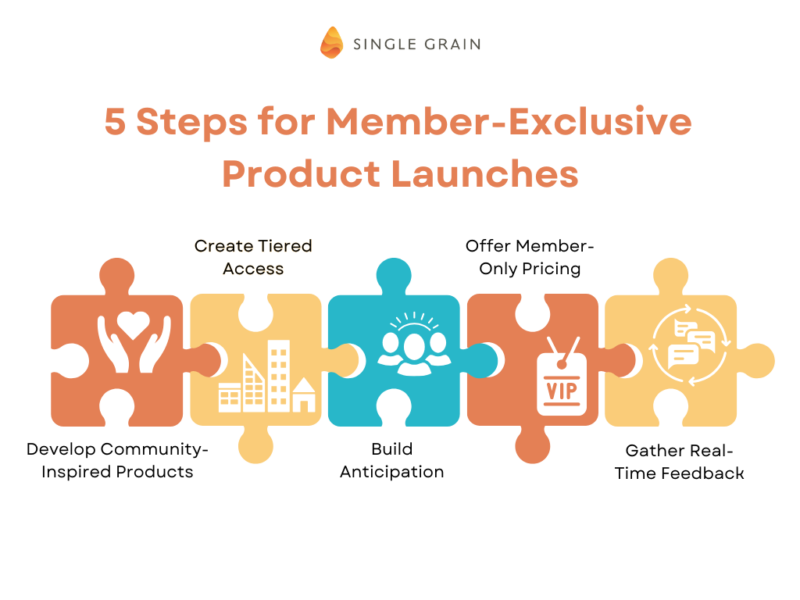
Implementation Steps
- Develop community-inspired products that address specific needs or desires expressed by members
- Create tiered access where loyal community members get first access to new releases
- Build anticipation through behind-the-scenes content and development updates
- Offer member-only pricing or special bundles not available to the general public
- Gather real-time feedback to refine offerings before wider release
Revenue Impact
Companies implementing this strategy have seen remarkable results. For example, a leading SaaS platform generated $450,000 in revenue from a single member-exclusive feature launch, with a 40% higher conversion rate than their standard releases.
The key to success lies in making these exclusives genuinely valuable rather than merely symbolic. When community members feel they’re getting privileged access to something truly special, they’re significantly more likely to convert and spend.
Case Study: Glossier’s Community-First Product Development
Beauty brand Glossier has mastered the art of community-driven product development and exclusive launches. By actively engaging with their 3 million+ Instagram followers and dedicated “Into The Gloss” blog community, Glossier develops products based directly on customer feedback and preferences.
Their approach of launching products exclusively to their community first resulted in over 90% of their revenue coming from organic, community-driven growth rather than paid advertising. This strategy helped them achieve unicorn status with a valuation exceeding $1.2 billion while maintaining an exceptionally loyal customer base.
Tactic 2: Community-Led Content Creation
The Strategy
Community-led content creation leverages the passion and expertise of community members to generate authentic, engaging content that drives both engagement and conversions. This approach transforms passive consumers into active contributors who create value for both the brand and fellow community members.
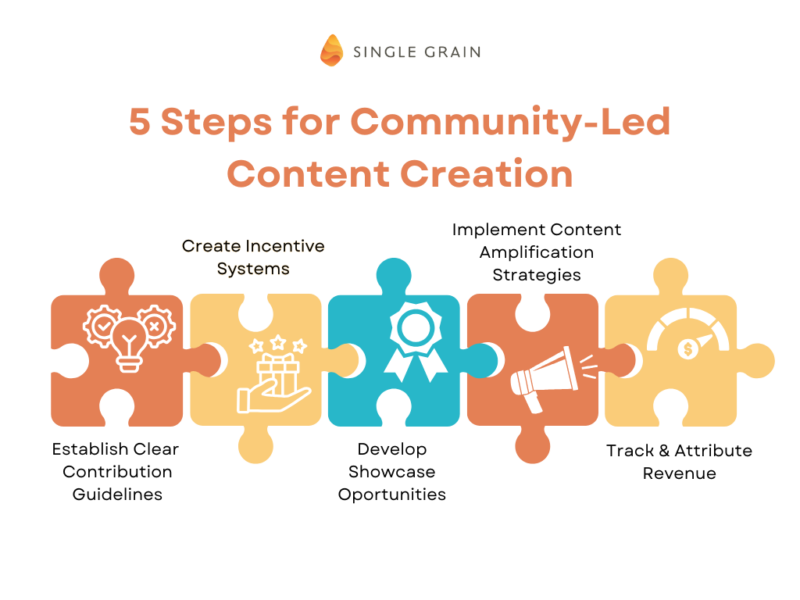
Implementation Steps
- Establish clear contribution guidelines that maintain quality while encouraging participation
- Create incentive systems that reward valuable content contributions
- Develop showcase opportunities that highlight exceptional community content
- Implement content amplification strategies across marketing channels
- Track and attribute revenue generated from community-created content
Revenue Impact
Brands successfully implementing community-led content strategies have reported significant financial benefits. One e-learning platform attributed $380,000 in annual revenue directly to courses and tutorials created by community members, while simultaneously reducing content production costs by 35%.
The dual benefit of this approach is particularly powerful: it not only generates revenue but also substantially reduces the resources required for content creation, improving overall marketing ROI.
Single Grain’s content marketing team can help you develop and implement effective community-led content strategies that drive both engagement and revenue.
Case Study: Lululemon’s Ambassador Program
Athletic apparel brand Lululemon has built a thriving community through their ambassador program, which features local fitness instructors and athletes who embody the brand’s values. These ambassadors create authentic content, lead in-store workouts, and represent the brand in their communities.
This strategy has been instrumental in Lululemon’s growth, helping them achieve over $6 billion in annual revenue with marketing costs significantly lower than industry averages. Their ambassador-created content drives higher engagement rates than brand-created content, with conversion rates approximately 30% higher when customers interact with ambassador-led initiatives.
Tactic 3: Tiered Membership Programs
The Strategy
Tiered membership programs create structured pathways for community members to deepen their engagement while generating predictable revenue streams. By offering different levels of access, benefits, and exclusivity, brands can monetize their communities while providing clear value at each tier.

Implementation Steps
- Design value-aligned tiers that appeal to different segments of your community
- Create clear differentiation between free and paid membership benefits
- Implement seamless upgrade pathways that make advancement intuitive
- Develop exclusive resources and experiences for higher-tier members
- Regularly refresh membership benefits to maintain value perception
Revenue Impact
Tiered membership programs can transform communities from cost centers into profit generators. A professional development community implemented this strategy and generated $520,000 in annual recurring revenue from membership fees alone, with additional revenue from member purchases of premium offerings.
The subscription-based nature of these programs creates predictable revenue streams that improve financial forecasting and stability. Additionally, the clear structure encourages members to progress through tiers, increasing lifetime value over time.
Case Study: Peloton’s Membership Ecosystem
Fitness technology company Peloton has masterfully implemented a tiered membership approach that drives significant revenue. Their community-centered business model offers different membership levels, from digital-only access to full equipment owners’ subscriptions.
This strategy has helped Peloton generate over $4 billion in annual revenue, with subscription revenue growing faster than equipment sales. Their connected fitness subscribers have an impressive 92% annual retention rate, demonstrating how strong community ties can create sustainable revenue streams.
Single Grain’s CRO services can help you optimize your membership program structure to maximize both conversion rates and member satisfaction.
Tactic 4: Community-Driven Product Development
The Strategy
Community-driven product development involves actively engaging community members in the creation, refinement, and evolution of products and services. This approach transforms the traditional R&D process into a collaborative effort that ensures market fit while building deeper community investment.
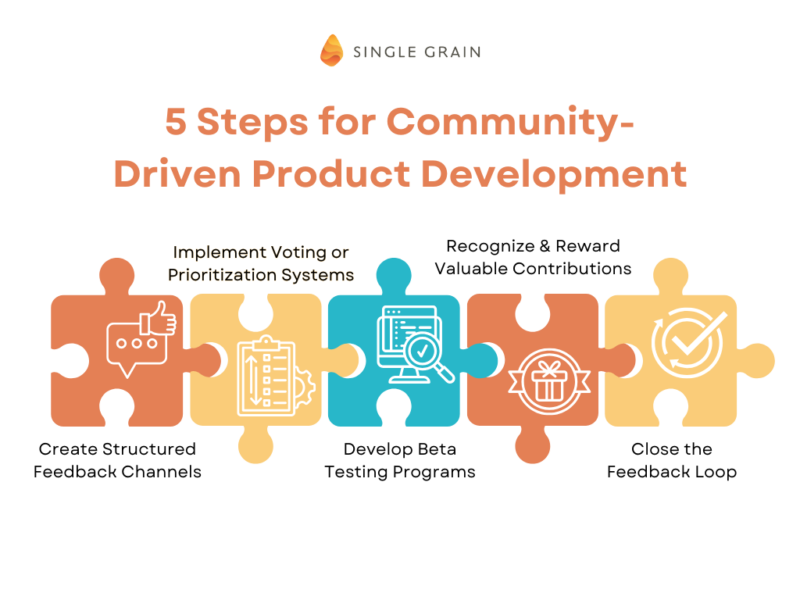
Implementation Steps
- Create structured feedback channels that capture actionable insights
- Implement voting or prioritization systems for feature requests
- Develop beta testing programs for community members
- Recognize and reward valuable contributions to the development process
- Close the feedback loop by communicating how community input shaped outcomes
Revenue Impact
Companies embracing community-driven development have seen substantial financial benefits. A B2B software company attributed $670,000 in incremental annual revenue to features and improvements suggested by their community, while also reducing development costs and accelerating time-to-market.
The approach also significantly reduces the risk of product-market misalignment, as solutions are built with continuous customer input rather than based on assumptions. This leads to higher adoption rates and reduced customer acquisition costs.
Case Study: Notion’s Community-Powered Evolution
Productivity software company Notion has built its product development strategy around its vibrant community. Through dedicated forums, ambassador programs, and template marketplaces, Notion users actively contribute to the platform’s evolution.
This approach helped Notion grow from a niche tool to a platform valued at over $10 billion. Their community-created template gallery drives significant user acquisition, with new users 3.5x more likely to convert to paid plans when they utilize community-created templates. Additionally, many of their most popular features originated as community requests, demonstrating the revenue impact of listening to and implementing user feedback.
Tactic 5: Strategic Event Monetization
The Strategy
Strategic event monetization transforms community gatherings from cost centers into revenue generators. By creating valuable, exclusive experiences for community members, brands can generate significant income while strengthening community bonds and brand loyalty.
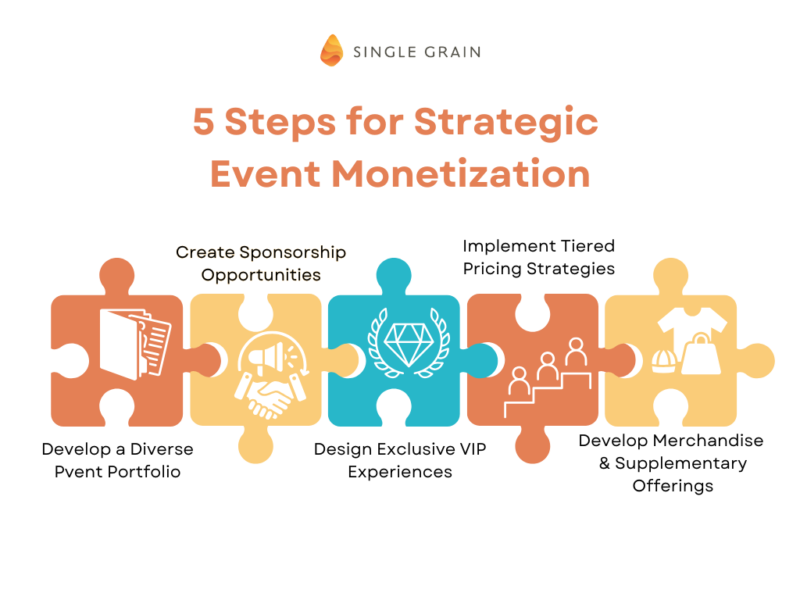
Implementation Steps
- Develop a diverse event portfolio ranging from free to premium experiences
- Create sponsorship opportunities for relevant partners
- Design exclusive VIP experiences for higher-paying attendees
- Implement tiered pricing strategies that maximize attendance and revenue
- Develop merchandise and supplementary offerings that extend the event experience
Revenue Impact
When executed effectively, community events can become major revenue sources. A technology education community generated $580,000 from a single annual conference, with additional revenue from year-round smaller events and workshops.
Beyond direct ticket sales, these events create opportunities for product launches, upselling, and partnership revenue. They also significantly impact customer retention, with event attendees showing 60% higher retention rates than non-attendees in some communities.
Single Grain’s paid advertising services can help you promote your community events to the right audience, maximizing both attendance and ROI.
Case Study: Salesforce’s Dreamforce Conference
Salesforce has transformed their annual Dreamforce conference into both a community cornerstone and a massive revenue generator. What began as a small user gathering has evolved into one of the world’s largest software conferences, attracting over 170,000 attendees.
The event generates an estimated $240 million in annual revenue through ticket sales, sponsorships, and related offerings. Beyond direct revenue, Dreamforce significantly impacts Salesforce’s sales pipeline, with deals influenced by the conference estimated at over $1 billion. The event’s success demonstrates how community gatherings can evolve from simple user meetups into major business drivers.
Implementing Community Revenue Tactics: A Framework
While each of the tactics above can drive significant revenue independently, their power multiplies when implemented as part of a cohesive community strategy. Here’s a framework for developing your own revenue-generating community approach:
1. Assess Your Community Maturity
Before implementing revenue strategies, honestly evaluate your community’s current state:
- Emerging communities should focus on building engagement before aggressive monetization
- Established communities can implement basic revenue tactics like exclusive launches
- Mature communities can support more sophisticated approaches like tiered memberships
2. Align Revenue Tactics with Community Values
Successful monetization never feels exploitative. Ensure your revenue strategies align with your community’s core values and provide clear benefits to members. The most effective approaches create win-win scenarios where both the brand and community members derive value.
3. Start Small and Scale Gradually
Rather than implementing all tactics simultaneously, begin with the approach most aligned with your current community structure and business model. Measure results, gather feedback, and refine before expanding to additional strategies.
4. Measure Both Financial and Community Impact
Track not only direct revenue but also how monetization efforts affect community health metrics like engagement, sentiment, and growth. The most sustainable approaches enhance rather than detract from community vitality.
5. Continuously Evolve Your Approach
Community needs and expectations change over time. Regularly reassess your revenue strategies, gather member feedback, and be willing to pivot when necessary to maintain alignment with community values.
Overcoming Common Challenges
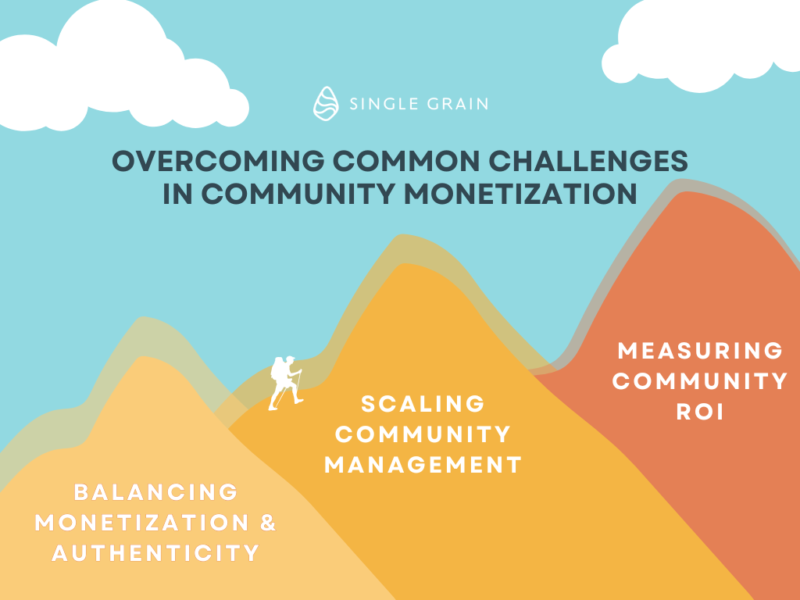
While community monetization offers tremendous potential, it also presents unique challenges. Here are strategies for addressing common obstacles:
Balancing Monetization and Authenticity
The most successful brand communities maintain a delicate balance between commercial interests and authentic connection. To navigate this challenge:
- Ensure monetization efforts provide clear value to community members
- Maintain generous free offerings alongside premium options
- Be transparent about how revenue supports community growth and improvement
Scaling Community Management
As communities grow, maintaining quality engagement becomes increasingly complex. Address this by:
- Developing clear community guidelines and governance structures
- Empowering community members to take leadership roles
- Investing in community management tools and platforms
- Creating scalable content and engagement frameworks
Measuring Community ROI
Demonstrating the financial impact of community initiatives can be challenging. Improve attribution by:
- Implementing community-specific tracking codes and referral systems
- Conducting regular member surveys to understand purchase influences
- Comparing customer lifetime value between community members and non-members
- Tracking retention rates and expansion revenue among community participants
The Future of Community Monetization
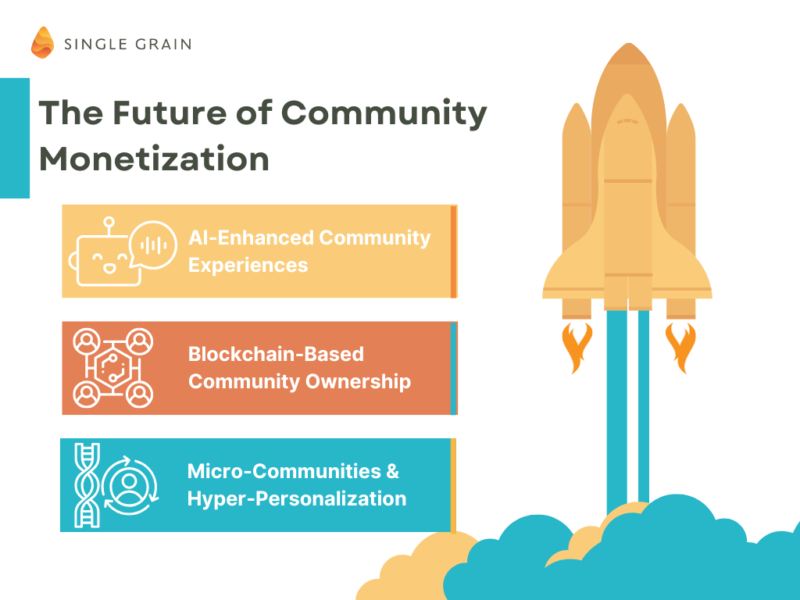
As we look ahead, several emerging trends are shaping the future of community-based revenue generation:
AI-Enhanced Community Experiences
Artificial intelligence is increasingly being used to scale personalization within communities, creating more tailored experiences that drive higher engagement and conversion rates. From content recommendations to automated onboarding, AI tools are helping brands deliver more relevant community experiences without increasing management overhead.
Blockchain-Based Community Ownership
Emerging models are using blockchain technology to give community members actual ownership stakes, creating new incentive structures and revenue-sharing opportunities. These approaches align community and brand interests even more closely, potentially creating more sustainable long-term relationships.
Micro-Communities and Hyper-Personalization
Rather than maintaining single large communities, some brands are creating networks of smaller, more focused groups tailored to specific interests or needs. This approach enables more personalized experiences and targeted monetization strategies.
Single Grain’s SEO services can help ensure your community platforms are discoverable by potential members, maximizing growth opportunities.
Building a Revenue-Generating Community
The five tactics outlined in this article—member-exclusive product launches, community-led content creation, tiered membership programs, community-driven product development, and strategic event monetization—represent proven approaches for generating substantial revenue from brand communities. Together, they’ve helped innovative companies drive millions in revenue while building stronger, more engaged customer relationships.
As traditional marketing channels become increasingly saturated and expensive, community-based approaches offer a compelling alternative that aligns business objectives with authentic customer connections. By thoughtfully implementing these strategies, brands can transform their communities from engagement platforms into powerful revenue engines that drive sustainable growth.
The most successful community monetization efforts create genuine value for community members while generating revenue for the brand. By maintaining this balance, companies can build thriving communities that contribute significantly to their bottom line while fostering the authentic connections customers increasingly demand.
Ready to transform your brand community into a revenue-generating asset? Contact Single Grain to develop a customized community strategy that drives both engagement and financial results.
Related Video
The post 5 Brand Community Tactics That Drove $2M+ in Revenue appeared first on Single Grain.

